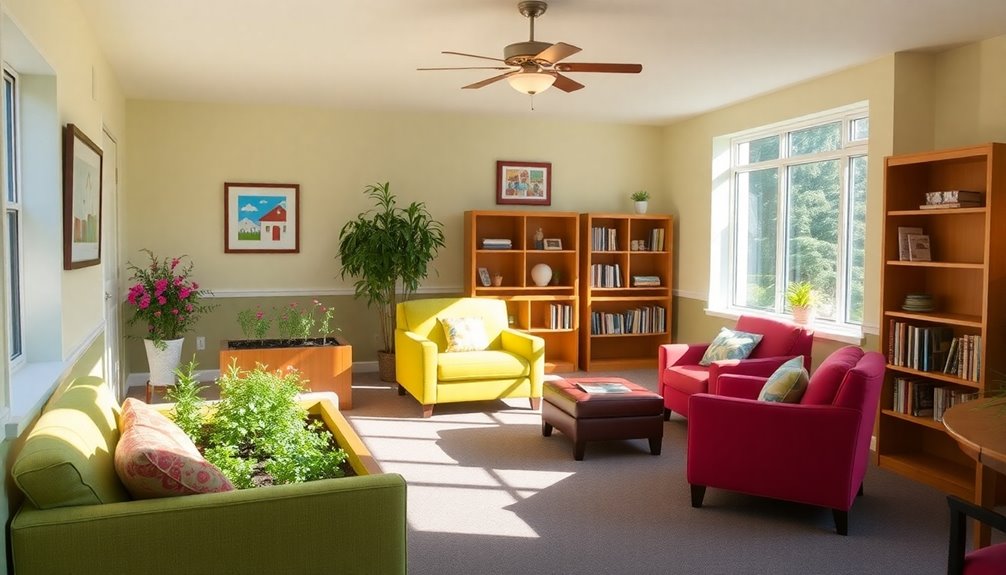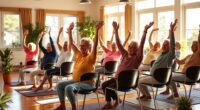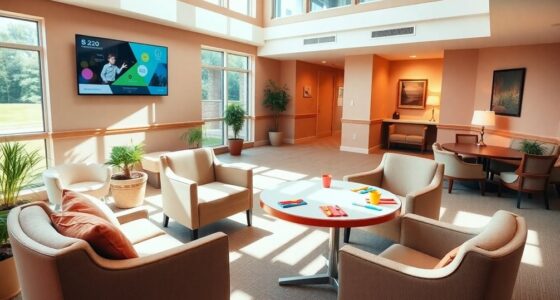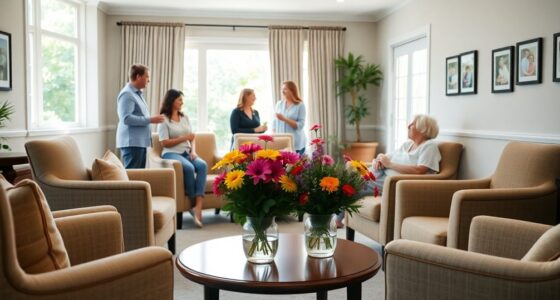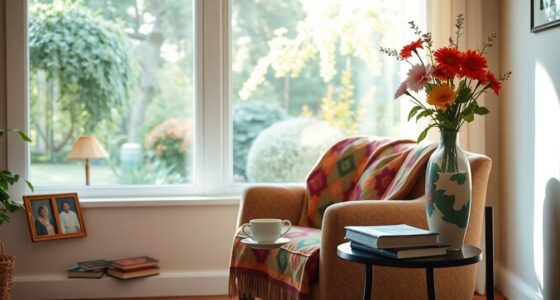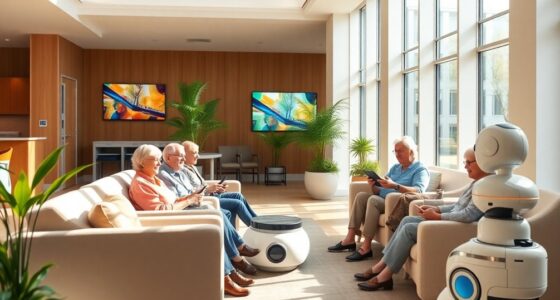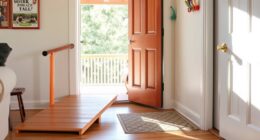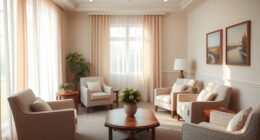To enhance safety and comfort in specialized care homes, consider installing grab bars and non-slip flooring to prevent falls. Ramps and wider doorways improve accessibility for mobility aids. Upgrade lighting for better visibility and mood, and implement smart technology to monitor residents' health. Create private, comfortable spaces with adjustable features and foster community engagement through shared areas and activities. Discover how these upgrades not only improve living conditions but also enrich residents' lives even further.
Key Takeaways
- Install grab bars in bathrooms and hallways to enhance safety and independence for residents, reducing fall risks.
- Upgrade to LED lighting to improve visibility, mood, and reduce energy costs by up to 75%.
- Implement non-slip flooring in high-risk areas to ensure safety without sacrificing aesthetics and style.
- Create communal spaces for social interaction and activities, reducing feelings of isolation among residents.
- Introduce smart technology for health monitoring, improving operational efficiency and enhancing resident safety.
Enhancing Safety With Grab Bars and Non-Slip Flooring
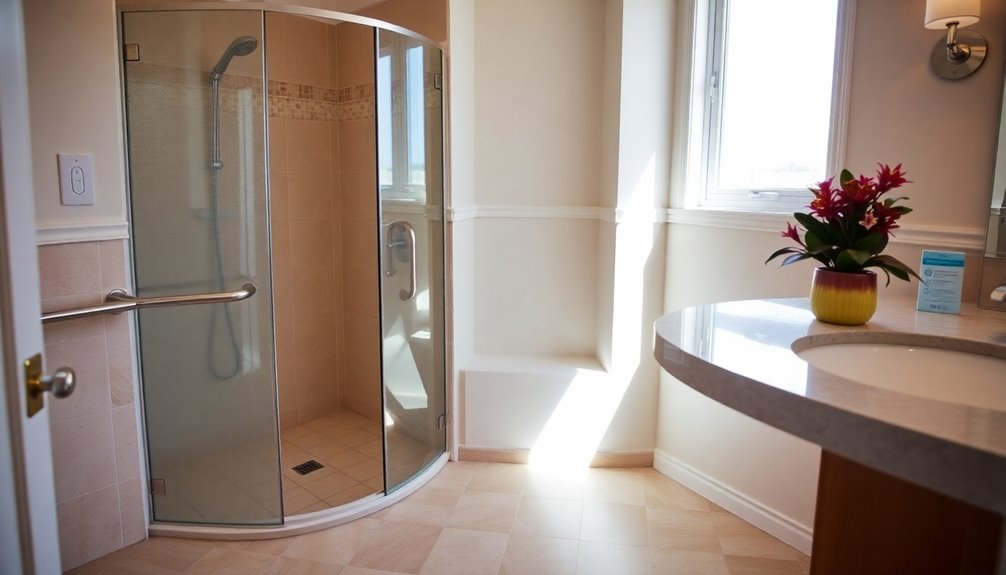
When you enhance safety in care homes, installing grab bars and non-slip flooring can make a noteworthy difference.
Grab bars in bathrooms, hallways, and near beds greatly reduce the risk of falls, providing residents with the support they need to maneuver safely. This not only boosts their confidence but also promotes aging in place, allowing them to live independently.
Non-slip flooring is equally essential, especially in high-risk areas like kitchens and bathrooms, where slips are common. Textured tiles and vinyl options guarantee that safety modifications don't compromise aesthetic appeal.
Improving Accessibility Through Ramps and Wider Doorways
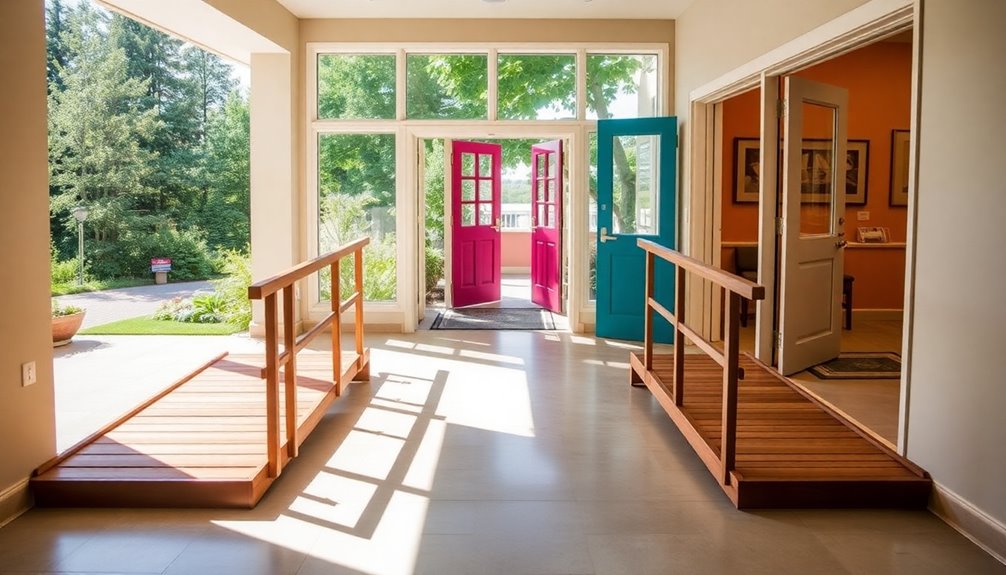
To improve accessibility in care homes, installing ramps and widening doorways is essential for residents with mobility challenges. Ramps allow easier entry and exit, greatly reducing the risk of falls associated with stairs.
Following the Americans with Disabilities Act (ADA), these home modifications create a truly accessible home. Wider doorways, ideally at least 36 inches, accommodate mobility aids like wheelchairs and walkers, ensuring residents can navigate freely without obstruction.
Properly designed ramps should maintain a slope ratio of 1:12, ensuring safety and usability. Implementing these upgrades not only meets legal compliance but also enhances the quality of life for residents, promoting their independence and ability to move comfortably throughout their living spaces.
Upgrading Lighting for Better Visibility and Mood
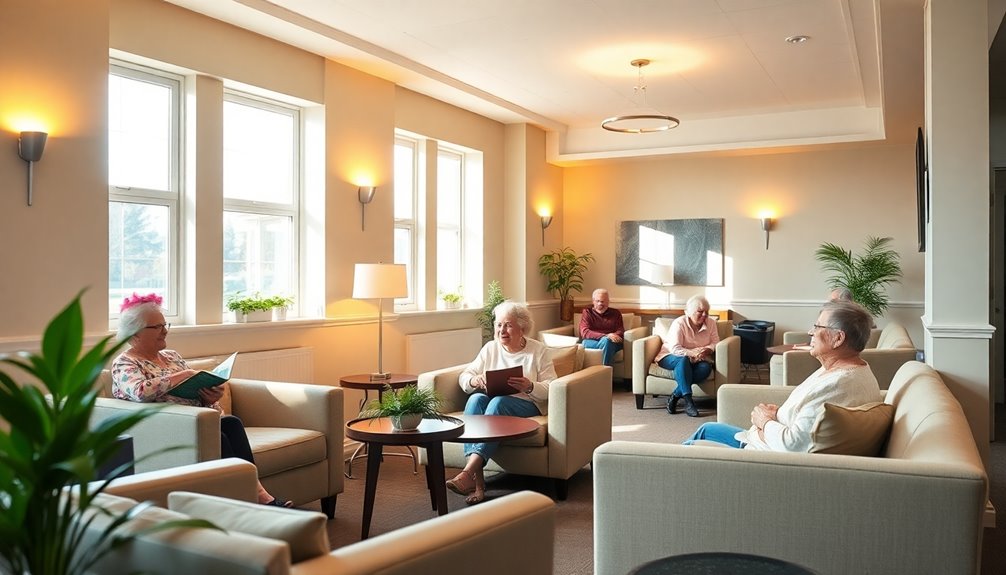
Upgrading the lighting in care homes can greatly enhance both visibility and mood for residents. By improving lighting quality, you reduce the risk of falls, allowing residents to navigate safely.
Studies show that natural light exposure boosts mood and cognitive function, leading to better overall health outcomes. Switching to LED lighting not only improves illumination but also cuts energy consumption by up to 75%, saving on utility bills.
Incorporating adjustable lighting options, like dimmers, lets caregivers tailor brightness for different activities, creating a more comfortable environment.
Additionally, properly designed lighting helps regulate circadian rhythms, which is crucial for residents' sleep patterns, ultimately promoting a better quality of life. Upgrading lighting systems can further enhance heat pump efficiency, ensuring that the overall environment remains comfortable and energy-efficient.
Investing in lighting upgrades is a smart move for any care home.
Implementing Smart Technology for Monitoring and Assistance
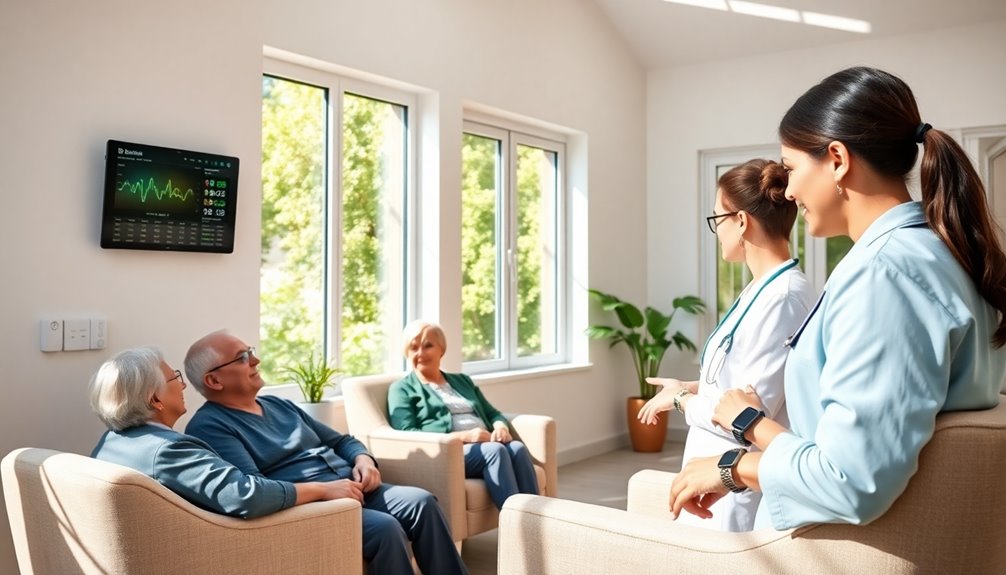
Implementing smart technology in care homes can transform how you monitor residents' health and respond to emergencies.
With remote health monitoring systems and emergency response automation, you can guarantee timely interventions while enhancing residents' independence.
Smart home integration further streamlines daily tasks, making life easier for both residents and staff. Additionally, the use of AI technology can significantly enhance cybersecurity measures, ensuring that sensitive resident data remains protected from potential threats.
Remote Health Monitoring Systems
Remote health monitoring systems are revolutionizing care homes by harnessing smart technology to track patients' essential signs in real time. By implementing these systems, you can markedly enhance chronic disease management, leading to a 50% reduction in emergency room visits.
With user-friendly interfaces and mobile applications, communication between patients, caregivers, and healthcare providers becomes seamless, ensuring timely interventions and early detection of health issues. Additionally, these systems can reduce hospital readmission rates by up to 25%, resulting in better patient outcomes and lower healthcare costs.
The integration of smart technology also boosts operational efficiency, potentially saving you around 20% on routine healthcare management through optimized resource allocation and reduced staffing needs. Furthermore, the implementation of strong encryption standards in these systems ensures that patient data remains secure against unauthorized access.
Emergency Response Automation
Every care home can greatly enhance resident safety and response times by adopting emergency response automation systems.
These systems utilize smart technology, such as sensors and alarms, to monitor residents' health in real time. This considerably reduces response times during emergencies, ensuring timely interventions.
Wearable devices can track essential signs and alert caregivers to any abnormalities, enhancing overall health care. Additionally, integrating smart home devices into these systems can further improve monitoring capabilities and overall safety.
Smart Home Integration
As technology continues to advance, integrating smart home solutions into care homes can greatly elevate the safety and independence of residents.
Smart home technology allows for remote monitoring of essential signs and alerts caregivers to emergencies, markedly reducing response times. Devices like smart sensors and cameras can detect unusual activity, helping to prevent falls and lowering incident rates by up to 30%.
Voice-activated assistants enable residents to control their environment, making daily tasks easier for those with mobility limitations. Additionally, smart medication dispensers guarantee adherence to medication schedules, improving compliance rates by over 50%.
Creating Private and Comfortable Spaces for Residents
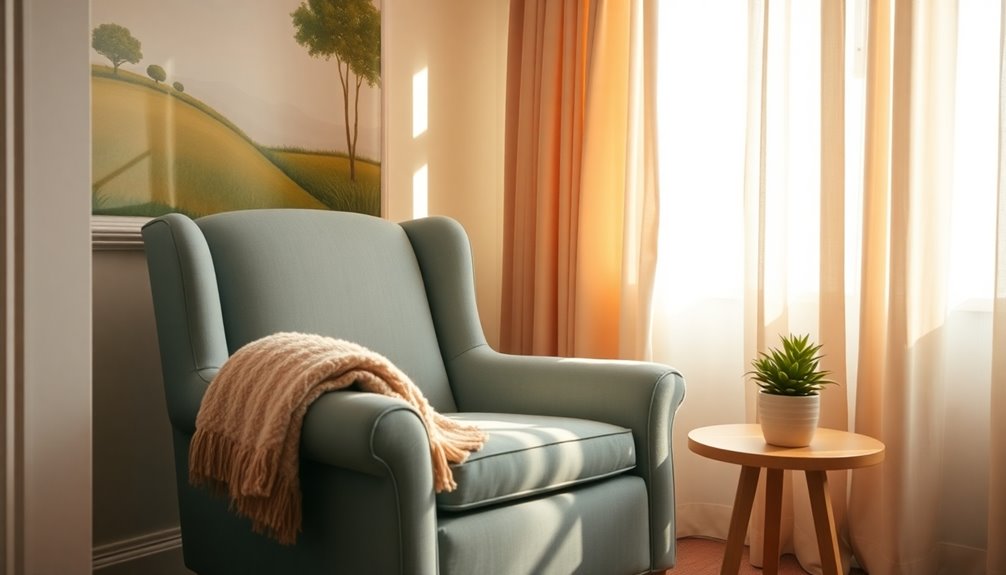
Creating a private and comfortable space for residents is essential for enhancing their overall well-being. Designing private rooms or semi-private rooms with soundproofing can greatly boost comfort and privacy, improving mental health and satisfaction.
Incorporating adjustable lighting and temperature controls allows residents to personalize their environment, catering to individual sensitivities. Additionally, using furniture that promotes accessibility, like adjustable beds and ergonomic seating, creates a supportive atmosphere for everyone.
Communal areas should also prioritize comfort, with cozy lounges and private nooks that encourage social interaction while offering retreats when needed.
Finally, large windows and nature views can enhance ambiance, promoting emotional health and a connection to the outside world, making every resident feel valued and at home. Moreover, incorporating natural materials can create a soothing environment that fosters relaxation and wellbeing.
Streamlining Operations With Efficient Staffing Schedules
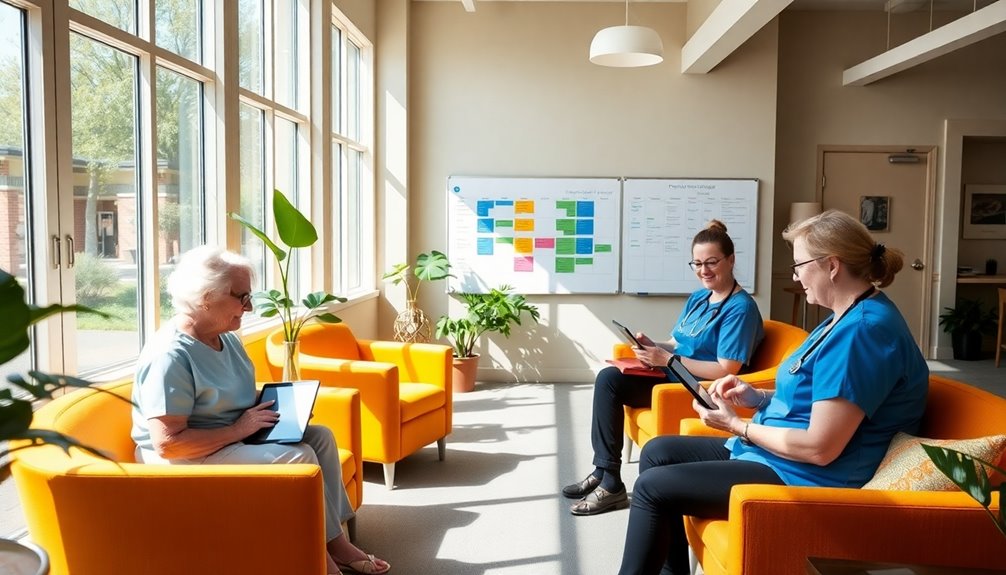
When you prioritize efficient staffing schedules, you can greatly enhance the operations of care homes while also improving resident satisfaction.
By optimizing staff-to-patient ratios, you can reduce labor costs by up to 20% without compromising care delivery. Implementing data-driven scheduling software helps predict peak service times, aligning staff availability with resident needs.
Regularly analyzing staffing patterns allows you to identify trends, reducing employee burnout and turnover by 30%. Cross-training staff in multiple roles adds flexibility, ensuring critical functions are covered during busy periods.
Establishing clear communication channels for shift changes streamlines operations and fosters collaboration among team members. This proactive approach not only enhances care delivery but also greatly boosts overall resident satisfaction in your facility. Additionally, fostering strong communication skills among staff can significantly enhance teamwork and service quality.
Fostering Community Engagement Through Shared Spaces and Activities

Efficient staffing not only streamlines operations but also paves the way for vibrant community engagement within care homes.
By creating shared spaces, like community rooms and gardens, you can encourage social interaction and reduce feelings of isolation among residents. Engaging in intergenerational activities, such as partnering with local schools for art or music programs, enriches lives and fosters connections.
Regularly scheduled community events—think potlucks or game nights—help strengthen relationships with local volunteers, providing essential emotional support.
Plus, incorporating accessible outdoor spaces for gardening or walking promotes active lifestyles that benefit both residents and the community. Additionally, utilizing mediation can help resolve any disputes regarding community resource allocation effectively, ensuring a harmonious environment.
Ultimately, these initiatives enhance satisfaction and quality of life, making community engagement a vital aspect of care home design.
Frequently Asked Questions
How Can We Improve the Quality of Care in Nursing Homes?
To improve the quality of care in nursing homes, you should prioritize higher RN staffing levels, as more coverage leads to better infection control and overall resident well-being.
You can implement regular training for staff on infection prevention and guarantee sufficient PPE stockpiles.
Listening to residents and families about their experiences is essential, as their feedback can guide improvements.
Finally, advocating for stricter regulatory enforcement will help maintain higher care standards across facilities.
What Are Home Modifications as a Way for an Older Person to Age in Place?
Home modifications help seniors savor safety and sustain independence.
These enhancements, like grab bars and non-slip flooring, create a comfortable, secure environment. By adapting your home, you can easily navigate familiar spaces, reducing risks of falls and accidents.
Consider consulting a certified Aging-in-Place Specialist for personalized advice, ensuring your modifications meet your unique needs.
Proactive planning is essential; the sooner you start, the safer and more enjoyable your living situation will be.
What Can I Do to Help Nursing Homes?
You can help nursing homes by advocating for better staffing ratios and supporting financial transparency initiatives.
Engage with local programs that promote home and community services, and push for enhanced infection control training for staff.
Encourage facilities to adopt quality care metrics and guarantee regular feedback from residents and families.
Volunteering your time or resources can also make a significant impact, fostering a more supportive environment for both residents and caregivers.
What Is a Home Modification Aid?
Imagine transforming a house into a safe haven where every step feels secure.
A Home Modification Aid is your key to making that happen. It's a financial assistance program designed to help you cover the costs of essential home changes, like installing grab bars or wheelchair ramps.
These modifications boost accessibility and safety, especially for seniors or those with disabilities, allowing you to enjoy a more independent and fulfilling life at home.
Conclusion
In a world where luxury often overshadows necessity, it's ironic that the most impactful upgrades for specialized care homes don't break the bank. By focusing on safety, accessibility, and community, you can create an environment that feels both welcoming and supportive. Investing in practical enhancements not only boosts residents' quality of life but also fosters a sense of belonging. Ultimately, it's the simple, cost-effective changes that make the biggest difference—proving that sometimes, less really is more.
